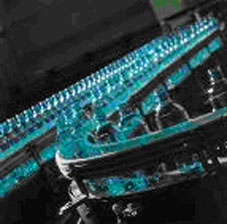The ideal lubrication system is simple to operate, environment-friendly and inexpensive, writes P.R. Palaniraj of Frost & Sullivan
TRACK treatment systems in non-alcoholic beverage industry help in managing package integrity and adapting sustainable practices for the producers. Synchronization of the conveyers in the beverage plant is improved by track treatment. Track treatment optimizes the packaging efficiency and maintaining product quality. Unplanned downtime causes greater disruptions in the manufacture process and lead to financial impact. Packaging lines must run efficiently with high degree of stability and lowest possible downtime. Beverage industries use slat conveyers to move the bottles, cans, packets and jars from one process step to another. In track treatment system, lubricants reduce friction between packages and conveyer belts. The major use of lubricant is to make the package move without friction and prevent them from falling from the conveyers. This helps increase the productivity and also improves the production efficiency of the plant by reducing the line stoppage due to bottle falling. Returnable and non-returnable glass bottles, PET, stainless steel cans, aluminum cans and cartons are some of the articles transported through the conveyers in food and beverage industry. Wet lubrication systems In the past, conventional wet lubrication system was used for lubricating the conveyers for non-alcoholic beverages. Water and soap-based or synthetic lubricant is the major component involved in wet lubrication system. Water contribution in wet lubrication system varies from 99 to 99.75% whereas the contribution of lubricant varies from 0.1 to 1%. If the plant uses soap-based lubricants for lubricating their lines, then the concentration will range from 0.25% to 1%, whereas by using synthetic lubricant, the concentration levels can be adjusted to fall between 0.25% and 0.5%. Difficulties faced by the end customers for wet lubrication are: ?Higher consumption of lubrication which increases the cost of production ?Choking of nozzles due to water hardness and improper selection of lubricants, this leads to bottles falling ?High load in effluent treatment plant ?Availability of service engineers For wet lubrication systems, the coefficient of friction should be in the range of 0.15 to 0.2. The conveyer chain requires frequent lubricity for smooth transfer from one slot to another. So lubrication is required to flow at regular intervals that are controlled by timers and solenoid valves.  Soap vs. synthetic Using soap-based lubricant may lead to reduction in efficiency of the plant due to fluctuation in water hardness leading to frequent nozzle blockages, which increases the plant maintenance cost. Wastage of water in wet lubrication system is very high and this increases the load in the effluent treatment plant. Lubricity of the conveyers plays a major role in the synchronization of conveyers. If the bottles falling from its original position reduce the speed of the conveyer, it automatically reduces the production efficiency. So, for better efficiency, the conveyers have to be lubricated on a regular basis. Dry lubrication system In the recent past, the non-alcoholic beverages industry has replaced wet lubrication systems with dry or water-free lubrication systems. All dry lubrication products are ready to use products and do not require water or any other substance to be added for lubrication. Friction between packages and conveyer belts are reduced drastically. For dry lubrication system the coefficient of friction is between 0.10 and 0.15. Some companies use brushes and others use nozzles to apply the dry lubricant on the slat conveyers. Both methods have their own advantages and disadvantages. Customers must decidNIKE AIR MAX
Soap vs. synthetic Using soap-based lubricant may lead to reduction in efficiency of the plant due to fluctuation in water hardness leading to frequent nozzle blockages, which increases the plant maintenance cost. Wastage of water in wet lubrication system is very high and this increases the load in the effluent treatment plant. Lubricity of the conveyers plays a major role in the synchronization of conveyers. If the bottles falling from its original position reduce the speed of the conveyer, it automatically reduces the production efficiency. So, for better efficiency, the conveyers have to be lubricated on a regular basis. Dry lubrication system In the recent past, the non-alcoholic beverages industry has replaced wet lubrication systems with dry or water-free lubrication systems. All dry lubrication products are ready to use products and do not require water or any other substance to be added for lubrication. Friction between packages and conveyer belts are reduced drastically. For dry lubrication system the coefficient of friction is between 0.10 and 0.15. Some companies use brushes and others use nozzles to apply the dry lubricant on the slat conveyers. Both methods have their own advantages and disadvantages. Customers must decidNIKE AIR MAX













